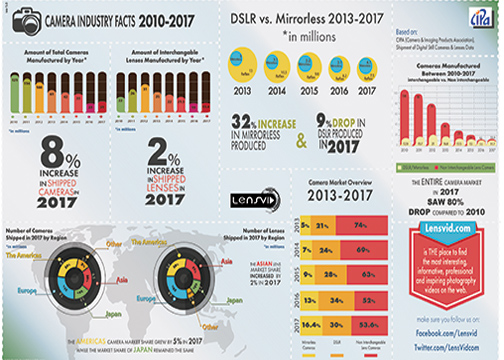
Las Vegas, NV—This is the fifth year that LensVid has monitored the photography industry via its community website. This year, after almost an entire decade of decline throughout the entire market, the company believes something has changed.
“As we have done each time before, we have updated our camera industry infographics to include the information CIPA (Camera & Imaging Products Association) recently published about the camera industry at the end of 2017.”
Based on this, LensVid asserts that 2010 was the top year ever for the camera industry. In 2010, 121 million cameras were produced. “Since then we have seen a steady decline with a huge drop in 2013 to only 61 million cameras—basically half. And in 2015 we saw another (almost) halving to only 35 million cameras. That was followed by another huge drop to only 23 million (35% drop, year-to-year).”
However, in 2017 the industry saw its first increase this decade with 25 million units. “This is barely over 8% increase, but at least the number stopped dropping,” stated LensVid.  “When comparing the number of non-interchangeable-lens (i.e., compact) cameras with that of interchangeable cameras (i.e., both DSLR and mirrorless), we see something interesting. For the first time since 2009, we see an increase in compact cameras. It went from the lowest point this decade in 2016 with only 12 million units, to 13.3 million in 2017. This was a 7% increase. The total number of interchangeable-lens cameras also increased from 11.3 million in 2016 to 11.7 million units in 2017. This is a modest increase of just over 3%.”
“When comparing the number of non-interchangeable-lens (i.e., compact) cameras with that of interchangeable cameras (i.e., both DSLR and mirrorless), we see something interesting. For the first time since 2009, we see an increase in compact cameras. It went from the lowest point this decade in 2016 with only 12 million units, to 13.3 million in 2017. This was a 7% increase. The total number of interchangeable-lens cameras also increased from 11.3 million in 2016 to 11.7 million units in 2017. This is a modest increase of just over 3%.”
LensVid added, “This means that despite some predictions (including ours by the way), the compact camera market in 2017 is still (a bit) larger than that of the interchangeable-lens cameras.
“When looking more closely at interchangeable-lens cameras, we can see that for the first time ever things are starting to change. While in 2016 we had 8.2 million DSLRs manufactured, in 2017 this number shrank to only 7.5 million. Mirrorless cameras rose to an all-time high—4.1 million cameras. This was a 32% increase compared to 2016.
“Looking at the bigger picture, we can see that compact cameras gained an extra 1.6% of the total market. DSLRs went down by about 4%. Mirrorless cameras grew by over 3% in the past year. As for lenses, the market almost didn’t change in 2017. We have seen a very minimal increase since 2016 from 19 million units to 19.4 million lenses or about a 2% increase.”
Notable for the U.S. market, LensVid stated: “Looking at the data by region, it seems that the camera market in the Americas grew the most in 2017. It grew by about 5% compared to 2016, while the Japanese market didn’t change at all. The lens market in Asia grew in 2017 by 3%; Europe and Japan actually saw 2% and 6% decreases, respectively.”
So What Does LensVid Conclude?
“Last year we predicted that it is likely that in 2017 we will see the global camera market go below 20 million units. We were wrong. Instead, the market jumped to 25 million units. This means we still have something to learn about the fundamental changes that the market is going through. . . .
“So far the DSLR segment of the market has been in a steady decline for at least six years. The mirrorless segment, on the other hand, was stagnant but had a big increase of over 32% in 2017.
“Even if we won’t see another huge increase in 2018 (and this actually might happen with the possible release of pro mirrorless models by both Canon and Nikon this year), the ratio of mirrorless to DSLR cameras out of the total interchangeable-lens cameras is going to increase and might be getting very close to a tie by the end of this decade.” lensvid.com





